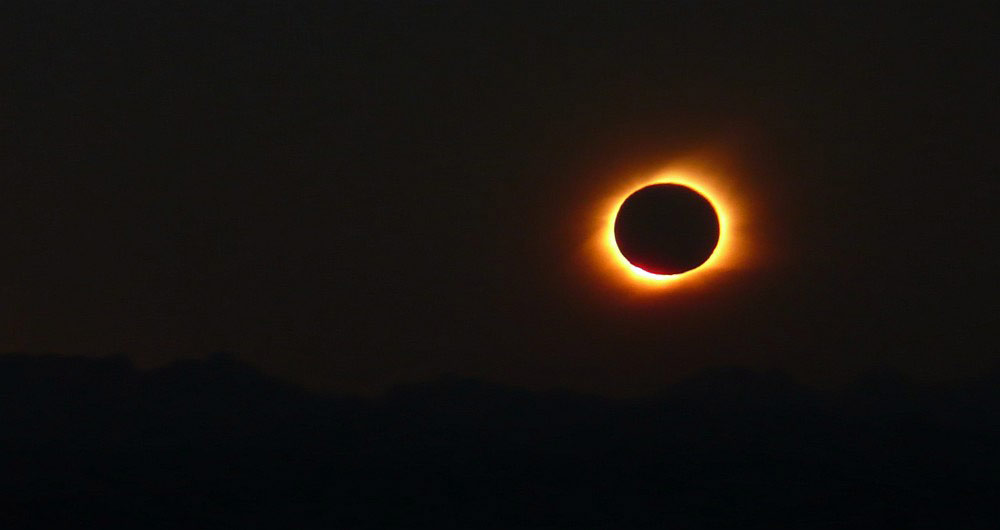Total Solar Eclipse Wows Skywatchers In South Pacific

A total solar eclipse arced across the southern PacificOcean Sunday, blotting out the sun and offering stunning views to skywatchers,some of whom ventured to remote islands or rode cruise ships just to see theevent.
For many, the most dazzling views were from EasterIsland, where astronomers and thousands of tourists watched the totalsolar eclipse from an island already renowned for its mysterious giant statues.?
"We observed the total eclipse in perfectly clearskies from Easter Island," Williams College astronomy professor JayPasachoff told SPACE.com in an e-mail. "The sky was wonderful."
It was the 51st solar eclipse for Pasachoff, who took aresearch team to Easter Island to study the sun's corona, or outer atmosphere.
During a total eclipse, when the disk of the sun isentirely blocked by the moon, the corona is suddenly visible as bright, wispytendrils that can be safely viewed with the naked eye. (Protective glasses arerequired to watch the phases of the eclipse before and after totality. Viewingthe sun's disk directly can cause permanent eye damage.)
The sun's corona dazzled observers with bright streamerspunctuated by diamond ring appearance of the sun and moon during theeclipse.
"The diamond rings were spectacular," Pasachoffsaid.
Breaking space news, the latest updates on rocket launches, skywatching events and more!
This solar eclipse was the second for 2010, but theonly one this year to be a total solar eclipse. A partial solar eclipse, alsoknown as an annular solar eclipse, occurred on Jan. 15.
The next total solar eclipse won't occur until November2012. [Totalsolar eclipse photos.]
Total solar eclipse, remote locations
Sunday's solar eclipse was touted as one of the mostremote eclipses ever. It was visible along a thousand-mile track that stretchedfrom a region north of New Zealand to the southern tip of South America.
While the eclipse offered up to 4 minutes and 41 secondsof totality at Easter Island, it made landfall at few other spots in the SouthPacific, among them: the Cook Islands, some French Polynesian atolls and the Patagoniaregion of Argentina, where the solar eclipse was visible as the sun set behindthe Andes mountains.
The global sky photography effort The World At Night(TWAN) stationed photographers all along the eclipse's visibility track,including onboard a chartered jet (which chased the solar eclipse across theocean), cruise ships, islands and in Patagonia. In addition to snapping photos,the photographers also hoped to share their passion of astronomy and astrophotographywith tourists and residents of the locations they visited, TWAN director BabakTafreshi told SPACE.com.
"Eclipse-chasing is not all about eclipses. It'salso a way to meet people and learn and respect other cultures,"Tafreshi said. "It's a chance to share your passion withothers."
Cruise ship spectacle
Eclipse-chaser Bill Kramer watched the solar eclipsefrom the deck of the cruise ship Paul Gaugin, which was sailing near Tahiti withmore than 300 eager skywatchers aboard as the moon blocked the sun. ?
"As to how it was ? well, wonderful," Kramertold SPACE.com in an e-mail. "It is hard to imagine what eclipse-chasersof 100 years ago would think of our luxury cruise vessel conveying us to anobscure point on the globe to watch an eclipse in style."
Kramer said the eclipse looked spectacular from his cruiseship vantage point, despite some clouds that cropped up during the event. ?
Kramer's total solar eclipse photos revealed the suncompletely obscured by the moon, leaving a fiery ring around the moon's edgeand brilliant coronal streamers that stretched out several times the width ofthe moon.
"The streamers stretched 4 to lunar diameters(depending on the observer) and the prominences were glorious in binoculars,"Kramer said.
Solar eclipse over Andes
In Argentina, many eclipse-chasers watched the moon blockthe sun from the El Calafate region near the Morena Glacier, but because of thelocation, the time of totality ? when the sun is completely obscured ? was amere two minutes.
Skywatcher Daniel Fischer of the University of Bonn inGermany took stunning photos of the solar eclipse over the Andes mountainrange and posted them on Twitter, where he writes as Cosmos4u.
Fischer said observers crowded the Mirador way, east ofEl Calafate, to see the solar eclipse spectacle. The event could even be felt oncethe moon completely blocked the sun.
"It *did* get cold in these two minutes,by the way," Fischer wrote.
Charles Fulco, a space and environmental systemscoordinator for schools in Port Chester, N.Y., was also at El Calafate with thegroup Eclipse City, Ltd., to watch the solar eclipse from a mountain perch morethan 3,280 feet (1,000 meters) up. The winds were strong but the sky was clearand blue during the event.
"The eclipse was beautiful, a golden-yellow color tothe corona and diamond rings," Fulco told SPACE.com in an e-mail, adding that it was a tough but rewarding trip. "Totallyexhausted but totally happy!"
- Gallery - 2008 Total Solar Eclipse Photos
- Beginner Astrophotographer Telescopes
- What Causes Solar Eclipses?
Join our Space Forums to keep talking space on the latest missions, night sky and more! And if you have a news tip, correction or comment, let us know at: community@space.com.

Tariq is the award-winning Editor-in-Chief of Space.com and joined the team in 2001. He covers human spaceflight, as well as skywatching and entertainment. He became Space.com's Editor-in-Chief in 2019. Before joining Space.com, Tariq was a staff reporter for The Los Angeles Times covering education and city beats in La Habra, Fullerton and Huntington Beach. He's a recipient of the 2022 Harry Kolcum Award for excellence in space reporting and the 2025 Space Pioneer Award from the National Space Society. He is an Eagle Scout and Space Camp alum with journalism degrees from the USC and NYU. You can find Tariq at Space.com and as the co-host to the This Week In Space podcast on the TWiT network. To see his latest project, you can follow Tariq on Twitter @tariqjmalik.
